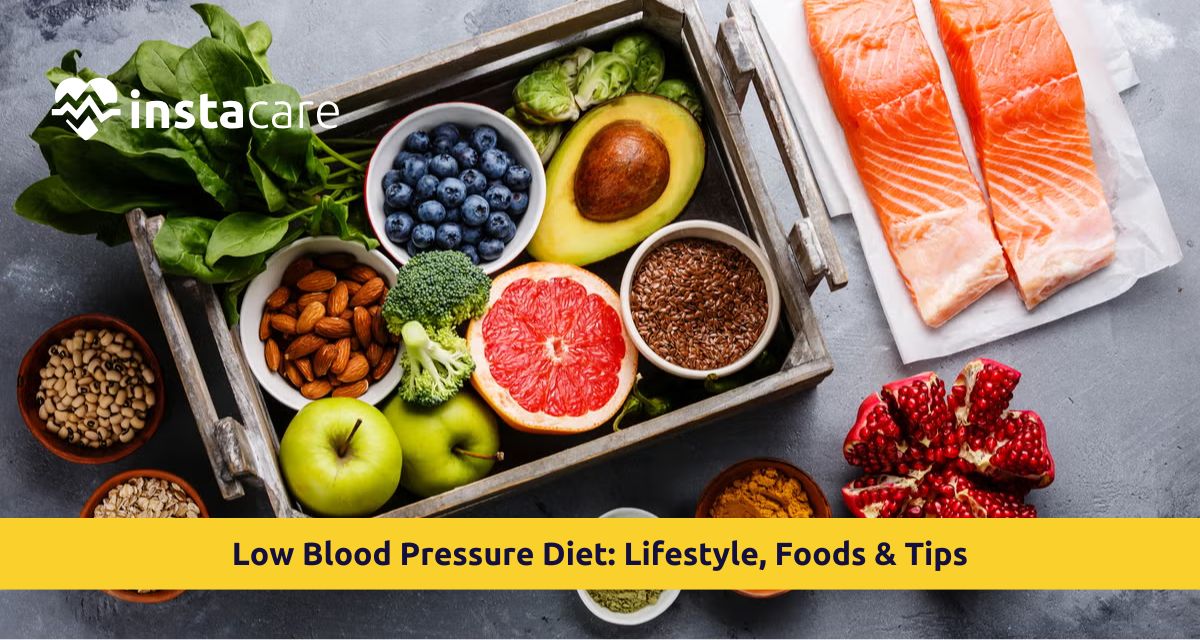What is Low Blood Pressure?
Low blood pressure, or hypotension, occurs when your blood pressure is lower than usual. All of your doctors would typically think of low blood pressure as being lower than 90/60 mmHg. But what is "low" can vary for various individuals.
Some of the most common symptoms of low blood pressure include:
- Dizziness while standing
- Fatigue in all directions
- Physical weakness
- Blurred vision
- Nausea and vomiting
- Fainting attacks
- Cold, damp skin
Others are naturally born with low blood pressure and they are just fine. Others experience symptoms that interfere with their normal lifestyle.
Role of Diet in Controlling Low Blood Pressure
Your diet for hypotension plays a crucial role in maintaining your status. Unlike the case of high blood pressure in which you limit your salt, low blood pressure has something unique. Best foods for low blood pressure can increase your blood volume and improve circulation.
A well-planned healthy diet for hypotension works in the following manner:
- Purging your body with more water
- Increasing the blood volume naturally
- Providing essential nutrients for a healthy heart
- Giving you energy all day long
- Permitting proper circulation
Best Foods to Include in a Low Blood Pressure Diet
The beginning of the list of best foods for low blood pressure starts with knowing what your body needs. The following are the best food groups to highlight:
Salt-Rich Foods
A salt-rich, low blood pressure meal plan can be effective if done correctly. Salt causes your kidneys to hold on to water, and that gets your blood more full. The following are good options:
- Pickled foods
- Canned soups and broths
- Milk and cheese
- Salted crackers
- Pretzels
- Olives and pickles
Reminder: Always check with your doctor before increasing the amount of salt that you consume, particularly if you have heart or kidney disease.
Iron-Rich Foods
Iron-rich foods for low blood pressure are needed as lower iron levels may increase hypotension. Include them in your diet:
- Lean red meat
- Poultry and fish
- Eggs
- Dark leafy greens such as spinach
- Beans and lentils
- Iron-fortified cereals
- Tofu and tempeh
High-Protein Foods
Protein for low blood pressure delivers consistent energy levels and does generally good for well-being:
- Chicken breast
- Turkey
- Fish such as salmon and tuna
- Greek yogurt
- Cottage cheese
- Nuts and seeds
- Quinoa
Complex Carbohydrates
These give slow-burning energy without causing blood sugar spikes:
- Whole grain bread
- Brown rice
- Oatmeal
- Sweet potatoes
- Whole wheat pasta
Most Important Vitamins
Vitamins for low blood pressure help your body maintain its own natural rhythms:
- Vitamin B12: In meat, fish, and milk foods
- Folate: In leafy green vegetables and fortified cereals
- Vitamin D: In fatty fish and fortified milk
- Vitamin C: In citrus fruits and berries
Read More: Hypotension (Low Blood Pressure): Symptoms, Causes & Treatment
Foods to Limit or Avoid during Low Blood Pressure
When planning your low blood pressure nutrition tips, there are certain foods that can make your symptoms worse:
Large, Heavy Meals
Large meals will decrease blood pressure even further after a meal. Instead:
- Eat 5-6 small meals during the day
- Eat modest-sized portions
- Don't skip meals
High-Sugar Foods
Too much sugar can make blood pressure fluctuate:
- Avoid candy and sweet treats
- Don't drink too much fruit juice
- Eat whole fruits instead of processed treats
Too Much Alcohol
Alcohol will lower blood pressure further:
- Limit alcohol to small quantities
- Never drink alcohol on an empty stomach
- Drink plenty of water when consuming alcohol
Too much caffeine
Some caffeine will be good, but too much will be an issue:
- Limit yourself to 1-2 cups a day before noon
- Notice how caffeine affects you
- Research green tea as a less potent option
Lifestyle Habits Beyond Diet for Low Blood Pressure
The following lifestyle tips for hypotension are often most beneficial when combined with optimal nutrition:
Optimal Hydration
Hydration for low blood pressure is crucial. Water keeps the blood volume and avoids dehydration-caused pressure drops:
- Drink 8-10 glasses of water every day
- Drink additional fluids in warm weather
- Use sports drinks with physical activity
- Carry a water bottle everywhere
Daily Exercise
Moderate to light exercise enhances circulation:
- Take daily 20-30 minute walks
- Swim or get water aerobics
- Gentle yoga
- Avoid surprise intense workouts
- Always gradually warm up
Better Sleep Habits
Good sleep enables your body to heal and have steady blood pressure:
- Sleep 7-9 hours a night
- Have consistent sleep schedule
- Have cozy sleeping environment
- Stay away from screens at night
Stress Management
Stress can affect blood pressure in many different ways:
- Do deep breathing
- Practice meditation or mindfulness
- Do an activity you enjoy that involves hobbies
- Speak with friends and family
- Visit a counselor if needed
Position Changes
Slow rising can prevent dizziness:
- Get up slowly from lying in bed
- Sit up slowly from the sitting position
- Use handrails, if available
- Exit bed slowly
Compression Clothing
These may be able to improve blood flow:
- Wear daytime compression stockings
- Choose knee-high or thigh-high
- Ask your physician for the correct level of compression
When to See a Doctor with Low Blood Pressure
Call your health care provider if you are experiencing:
- Recurring syncope episodes
- Dizziness interfering with normal daily activities
- Shortness of breath or chest pain
- Severe headache
- Disorientation or lack of concentration
- Worsening of symptoms with time
Your physician may need to:
- Eliminate underlying medical conditions
- Tune current medications
- Prescribe specialty therapies
- Monitor your progress
Conclusion
Managing low blood pressure with a low blood pressure treatment diet and lifestyle adjustments is usually highly effective. The secret is including the correct amount of salt, water, and nutrients for your body. Keep in mind that trying out low blood pressure nutrition tips is something that works over time, so be patient. Success is accomplished through gradual modification and adhering to them persistently. Improvement is noticed in most people between 2-4 weeks of maintaining what to eat for low blood pressure guidelines regularly.
Always have your medical team check it over to ensure your plan will be safe and will be effective for your individual case. They can help craft a plan that is tailored to your overall health and any medications that you are taking.
Please book an appointment with the
Best Nutritionist in Lahore, Karachi, Islamabad, and all major cities of Pakistan through
InstaCare, or call our helpline at 03171777509 to find a verified doctor for your disease.

